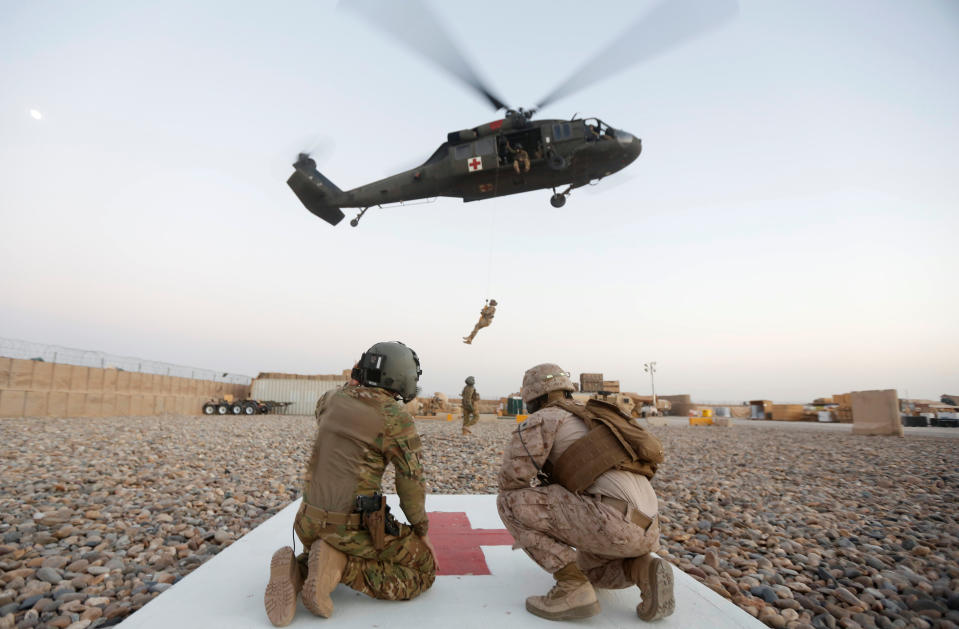Trump's Afghanistan war speech: What to watch for
WASHINGTON — After years of calling for a U.S. withdrawal from Afghanistan, President Trump will use a prime-time speech late Monday to lay out his long-awaited strategy for fighting America’s longest war. Trump is expected to accept the Pentagon’s recommendation to send a few thousand more troops to the strife-torn country nearly 16 years after the conflict began.
The announcement caps months of frequently angry West Wing debates pitting advisers advocating deeper involvement in Afghanistan against aides warning that Trump risks getting sucked into the kind of nation-building entanglement he denounced during the 2016 campaign. It also comes after the departure of senior strategist Steve Bannon, the most forceful West Wing voice against escalating the conflict.
The president considered a range of options, from full withdrawal to significant escalation, and even one plan (which was never seriously in play) to replace troops with contractors under a “viceroy” figure.
Whatever Trump announces, the strategy will be a defining part of his presidency. Here are some things to watch for when the president addresses the nation from Fort Myer, Va.
How many more Americans will go to war?
While Trump is expected to agree to his national security team’s recommendation for a modest escalation of U.S. troops in Afghanistan, officials declined on Monday morning to put a number on it. And the president could also decide not to give a precise figure in his speech, focusing instead on the importance of the mission.
The United States has about 8,400 troops in Afghanistan, part of an international force roughly 13,500 strong. A few months ago, Trump authorized Defense Secretary James Mattis to deploy another 3,900, a step the retired general declined to take in the absence of a fleshed-out strategy.
The Pentagon has been asking for “thousands” more troops since January, when Gen. John Nicholson, the top U.S. commander in Afghanistan, told Congress the conflict was at a “stalemate.”
Since George W. Bush unleashed U.S. military might against the Taliban on Oct. 7, 2001, some 2,400 Americans have died in the conflict and more than 20,000 have been wounded. Barack Obama surged tens of thousands of troops into Afghanistan in 2009 but later drew frequent criticisms from Republicans, who accused him of focusing on withdrawing U.S. forces rather than defeating the Taliban. Obama aides said their main goal was making local security forces self-sustaining in order to extricate the United States from a seemingly intractable conflict.
The potential U.S. escalation leads to two other questions. How many U.S. service members will go? And how many new NATO forces will join in, if any?

To do what?
The new deployments are expected to shoulder two main tasks: Shore up Afghan security forces fighting the Taliban and carry out missions targeting al-Qaida and the so-called Islamic State.
For how long?
Trump is not expected to set a target withdrawal date, effectively committing to an open-ended deployment. And Mattis told Congress in mid-June that Americans should expect a “residual force” to stay in Afghanistan for the foreseeable future.
What are Trump’s expectations for the Afghan government?
The notion of a deployment without an defined end date may alienate parts of Trump’s base, which opposes overseas missions for the purpose of nation-building.
But the president could make continued U.S. economic and military aid contingent on the Afghan government reaching some to-be-determined benchmarks for rooting out corruption and delivering much-needed services. Senate Armed Services Committee Chairman John McCain, R.-Ariz., included the notion in his own proposed Afghan war strategy, which he unveiled not quite two weeks ago.

What are Trump’s expectations for the Pakistani government?
When the president huddled at Camp David on Friday with his national security team, the meeting was billed as a discussion of policy towards South Asia — not just Afghanistan.
That’s because there’s no realistic Afghan war strategy without a Pakistani component. U.S. officials have long accused Islamabad of supporting extremists like the Haqqani network, fomenting instability in Afghanistan and even targeting U.S. forces.
And yet Washington hasn’t found a way to get nuclear-armed Pakistan – officially a “major non-NATO ally” that gets privileged access to purchases of military hardware – to change its behavior. And U.S. officials are mindful of the risks of any policy that risks weakening the government in Islamabad.
In one of the most memorable phrases of the nearly 16-year-old war, Rep. Gary Ackerman, D-N.Y., described the relationship between the two neighbors as “a shack that’s on fire” (Afghanistan) “located next to the dynamite factory” (Pakistan).
How will Trump sell the policy to America?
It’s become a cliché to call Afghanistan “the forgotten war.”
But it’s largely true. Trump and his Democratic rival for the White House, former Secretary of State Hillary Clinton, did not face any questions about the conflict in any of their three debates in late 2016. And national polling on the conflict is sparse after October 2015.
Using his personal Twitter megaphone, the president has for years called for a complete withdrawal.
“Let’s get out of Afghanistan. Our troops are being killed by the Afghanis we train and we waste billions there. Nonsense! Rebuild the USA,” he tweeted in January 2013.
If, as expected, he chooses to deepen U.S. involvement, how will he sell the idea to his core voters, and to lawmakers who will be called upon to fund the new deployment?

How will Trump define victory — or at least success?
“Now, we never win a war. We never win. And we don’t fight to win. We don’t fight to win,” Trump complained to the National Governors Association in late February. “So we either got to win or don’t fight it at all.”
When President George W. Bush announced on Oct. 7, 2001, that he was going to war in Afghanistan, he laid out key goals like rooting out al-Qaida, but he was careful not to define victory. Late that month, Bush aides expressed outrage at a New York Times article warning that Afghanistan could become a “quagmire,” and suggesting that the new conflict could become “another Vietnam.”
Nearly 16 years later, the Trump administration is wrestling with how to define an elusive victory, or at least satisfactory success.
Inside the Trump administration and among outside experts, there’s a general consensus that America’s foremost national security goal is to prevent Afghanistan from slipping back into its pre-9/11 state as a safe haven for extremists plotting to strike at America or its allies.
But Trump himself has never spelled out what he would consider success. Monday night could be his best chance to do so.
Read more from Yahoo News:



